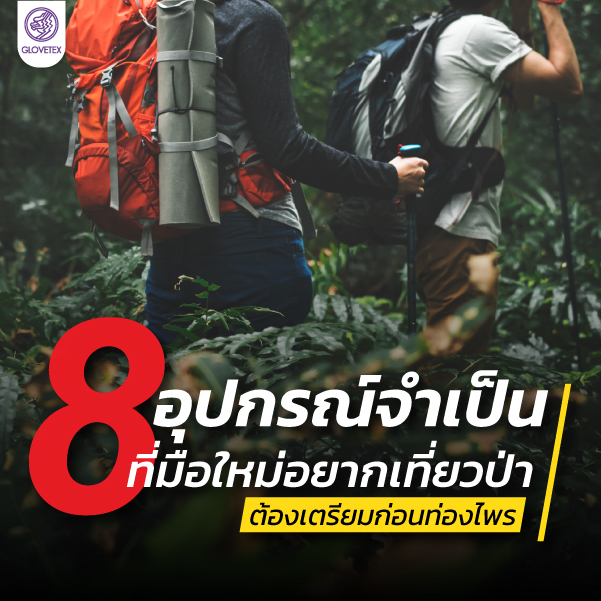8 Essential Gear for Beginners Heading into the Wilderness

[vc_row equal_height=”yes” content_placement=”middle”][vc_column width=”2/3″ css=”.vc_custom_1639965740524{border-top-width: 15px !important;border-right-width: 15px !important;border-bottom-width: 15px !important;border-left-width: 15px !important;padding-top: 150px !important;padding-bottom: 150px !important;background-image: url(https://glovetex.com/wp-content/uploads/2021/12/8เที่ยวป่า-01.jpg?id=4085) !important;background-position: center !important;background-repeat: no-repeat !important;background-size: cover !important;border-left-color: #ffffff !important;border-left-style: solid !important;border-right-color: #ffffff !important;border-right-style: solid !important;border-top-color: #ffffff !important;border-top-style: solid !important;border-bottom-color: #ffffff !important;border-bottom-style: solid !important;}”][/vc_column][vc_column width=”1/3″ css=”.vc_custom_1618587353573{border-top-width: 15px !important;border-right-width: 15px !important;border-bottom-width: 15px !important;border-left-width: 15px !important;padding-top: 30px !important;padding-right: 30px !important;padding-bottom: 30px !important;padding-left: 30px !important;background-color: #f2f2f2 !important;border-left-color: #ffffff !important;border-left-style: solid !important;border-right-color: #ffffff !important;border-right-style: solid !important;border-top-color: #ffffff !important;border-top-style: solid !important;border-bottom-color: #ffffff !important;border-bottom-style: solid !important;}”][vc_column_text]
This winter, many people planning a trekking trip should start preparing essential gear for their wilderness adventure. This type of travel is popular among both young adults and professionals, and Thailand offers many beautiful trekking destinations. Each location is stunning and a highlight of travel in Thailand.
If you want to go trekking, you need to prepare essential equipment. It’s not just about having stylish outfits for photos but also ensuring effectiveness and safety during your trek.
[/vc_column_text][/vc_column][/vc_row][vc_row css=”.vc_custom_1618492982393{margin-top: 30px !important;}”][vc_column][vc_column_text]
[/vc_column_text][/vc_column][/vc_row][vc_row css=”.vc_custom_1618492982393{margin-top: 30px !important;}”][vc_column width=”1/2″][vc_column_text]
1. Backpack and Clothing
When choosing a backpack, opt for one made of durable materials that can handle the weight while remaining lightweight. Consider the total weight of the items you’ll need to carry throughout the journey. For clothing, select garments that are breathable, lightweight, and not too thick. Long-sleeve shirts are recommended to protect against scratches from branches, though arm sleeves can be used as an alternative for those who prefer short sleeves. While jeans can be worn, specialized trekking pants are preferable for better comfort and breathability. Don’t forget to pack a rain jacket as well.
[/vc_column_text][/vc_column][vc_column width=”1/2″][porto_image_frame image_id=”4091″][/porto_image_frame][/vc_column][/vc_row][vc_row css=”.vc_custom_1618492982393{margin-top: 30px !important;}”][vc_column width=”1/2″][porto_image_frame image_id=”4084″][/porto_image_frame][/vc_column][vc_column width=”1/2″][vc_column_text]
2. Footwear and Socks
Footwear is crucial, second only to the backpack. The best trekking shoes should have a rubber sole for better grip on trails, ankle support, and be waterproof. Choose a pair that fits well. Don’t forget to wear comfortable socks to keep your feet cushioned, as each trek will likely cover at least 1-2 kilometers.
[/vc_column_text][/vc_column][/vc_row][vc_row css=”.vc_custom_1618492982393{margin-top: 30px !important;}”][vc_column width=”1/2″][vc_column_text]
3. Sleeping Bag and Tent
If you plan to trek for more than one day, a sleeping bag and tent are essential for overnight stays in the wild. Necessary gear includes the tent, sleeping bag, inflatable mattress, and a hammock. Temperatures in the forest are often lower than usual, even in summer, as it’s perpetually cool, like having air conditioning. Therefore, if you’re camping, invest in a high-quality tent and sleeping bag. The tent should be made of water-resistant fabric and include a mesh layer to keep out insects. The sleeping bag should be lightweight, provide excellent insulation, and have adequate padding to keep you warm.
[/vc_column_text][/vc_column][vc_column width=”1/2″][porto_image_frame image_id=”4087″][/porto_image_frame][/vc_column][/vc_row][vc_row css=”.vc_custom_1618492982393{margin-top: 30px !important;}”][vc_column width=”1/2″][porto_image_frame image_id=”4092″][/porto_image_frame][/vc_column][vc_column width=”1/2″][vc_column_text]
4. Emergency Gear
Always bring essential first aid supplies, including a basic first aid kit and any personal medications you might need. This is crucial in case of injury or accidents during your trek. Additionally, don’t forget to pack mosquito repellent and tick repellent to protect yourself from insects.
[/vc_column_text][/vc_column][/vc_row][vc_row css=”.vc_custom_1618492982393{margin-top: 30px !important;}”][vc_column width=”1/2″][vc_column_text]
5. Flashlight and Spare Batteries
As night falls, the forest will become pitch dark, so it’s essential to bring a flashlight or a battery-powered lantern. This will enhance safety and help you see your surroundings. If you plan to start a campfire, remember to bring matches or a lighter as well. Additionally, carry spare batteries or a power bank for your phone. Even though there might be no cell signal in the forest, you can use the power bank to charge your phone for capturing memorable moments.
[/vc_column_text][/vc_column][vc_column width=”1/2″][porto_image_frame image_id=”4089″][/porto_image_frame][/vc_column][/vc_row][vc_row css=”.vc_custom_1618492982393{margin-top: 30px !important;}”][vc_column width=”1/2″][porto_image_frame image_id=”4088″][/porto_image_frame][/vc_column][vc_column width=”1/2″][vc_column_text]
6. Map and Compass
Even though we all carry phones these days, signal reception can be limited or nonexistent in the forest. So, don’t forget to bring a map and a compass. It’s also crucial to practice using them before your trip to ensure you can navigate effectively when needed.
[/vc_column_text][/vc_column][/vc_row][vc_row css=”.vc_custom_1618492982393{margin-top: 30px !important;}”][vc_column width=”1/2″][vc_column_text]
7. Cooking Gear and Water Bottle
Food and drinks are essential when trekking. If you run out of energy, you can grab some snacks to recharge. Even if you’re not staying overnight, carry a water bottle to stay hydrated throughout the day. Also, don’t forget to pack cooking gear if you plan to camp overnight, such as a portable stove, pot, plates, bowls, and utensils. And, of course, your water bottle is crucial for staying hydrated on the trail.
[/vc_column_text][/vc_column][vc_column width=”1/2″][porto_image_frame image_id=”4093″][/porto_image_frame][/vc_column][/vc_row][vc_row css=”.vc_custom_1618492982393{margin-top: 30px !important;}”][vc_column width=”1/2″][porto_image_frame image_id=”4090″][/porto_image_frame][/vc_column][vc_column width=”1/2″][vc_column_text]
8. Trekking Poles
Trekking poles are incredibly useful for hiking as they help reduce impact on your knees and joints. They are especially handy when crossing streams or rough terrain. Make sure to check the quality before purchasing, including the handle, locking mechanism, and rubber tips.
[/vc_column_text][/vc_column][/vc_row][vc_row css=”.vc_custom_1618492982393{margin-top: 30px !important;}”][vc_column][vc_column_text]
Hiking Safety Tips
Be sure to pack only the essential items in your backpack to avoid excessive weight and shoulder pain. If the weather is hot, consider bringing a thermos with cold water or a mix of juice and ice to sip throughout the day. Carry 1-2 bars of chocolate for an energy boost. While hiking, move at a steady pace, breathe deeply, and stick with your group. Do not stray from the designated trail. If you feel unwell, short of breath, or unable to continue, inform your team and the authorities immediately—do not push yourself, as it could be dangerous.
Hiking and trekking can be enjoyable and achievable if you prepare properly. With the right equipment and preparation, you can conquer this adventure successfully.
For newcomers, these 8 essential hiking items we recommended are just the beginning. There are many other tools and gear needed depending on the duration and distance of your hike. Always check that your gear is adequate for the trip and remember that safety equipment and emergency supplies are crucial.
[/vc_column_text][/vc_column][/vc_row][vc_row css=”.vc_custom_1618492982393{margin-top: 30px !important;}”][vc_column][porto_image_frame image_id=”4083″ link=”url:https%3A%2F%2Fglovetex.com%2F%3Fs%3DSLEEVE%26post_type%3Dproduct”][/porto_image_frame][/vc_column][/vc_row]

